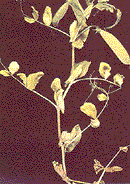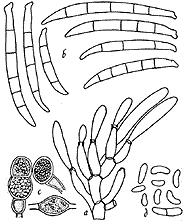Reports on Plant Diseases |
| RPD No. 912
- Wilt Diseases of Pea
|
October 1988
|
[ Symptoms
] [ Disease Cycle ] [ Control
]
Peas are susceptible to two similar wilt
diseases caused by Fusarium oxysporum f. sp. pisi; true wilt and near
wilt. True wilt or Fusarium wilt is caused by Race 1 of the fungus while
near wilt is caused by several races. Currently, 10 races of the near
wilt fungus have been reported, designated Races 2 ato 11. Race 2 predominates
in Illinois. Wilt-affected plants are more difficult to pull from the
soil than those damaged or killed by root rots (see Report
on Plant Diseases No. 911). If wilt-infected plants are not examined
until wilt symptoms have been apparent for several days, root-rotting
fungi in the soil may have so damaged the roots that it is almost impossible
to identify the organism responsible. Both wilt diseases occur worldwide
wherever peas are grown more or less continuously. Near wilt is more common
than true wilt because many more pea varieties are available which are
resistant to true wilt.
Back to Top
SYMPTOMS
Fusarium or True Wilt. Plants may become
infected at any stage of growth. The first symptoms are usually a yellowing
of the lower leaves and a stunting or dwarfing of plant growth (Figure
1). The stipules and margins of the leaflets curl downward and inward.
The stems at or near the soil line may be slightly thickened and brittle.
A cross section of the lower stem often reveals a lemon to orange-brown
and finally black discoloration of the water-conducting tissue (xylem)
within the stem. Affected plants may wilt and die either slowly or rapidly
soon after the first symptoms are noted due to destruction of the feeder
roots. Affected plants die more rapidly in very dry than in moist soils.
If infection occurs when the plants are fairly young, they often wither
and die without producing any pods. If they are larger when infected,
a few flattened and poorly filled pods may form. The disease occurs in
circular to oval areas in the field. If the soil is not uniformly infested,
the symptoms appear on isolated plants scattered throughout a field. If
susceptible pea varieties are planted several years in succession in the
same field or garden area, the infested areas gradually enlarge, become
more numerous, and later merge with others. Finally, all of the soil in
the field or garden may become infested.
Near wilt. Like true wilt, plants may
become infected at any stage of growth. Seedlings may emerge, collapse,
and die (damp-off). When slightly older plants are affected, a black canker
develops on the stem close to where the seed is attached. The canker enlarges
both upward and downward. Finally, the entire outer part (cortex) of the
tap root may be affected. Aboveground symptoms are quite similar to those
for Fusarium wilt. However, plants affected
with near wilt die more slowly, and the water-conducting tissues in some
plants are orange to bright brick red. The discoloration may run up the
entire plant. Near wilt affects pea varieties that are resistant to wilt
and is more apt to kill plants later in the season, sometimes after the
crop is nearly mature. For this reason the loss from near wilt is less
than that from Fusarium wilt. Near wilt may
be readily overlooked because the pale, greenish yellow, stunted appearance
of the plants may be attributed to root rot, lack of soil fertility, or
another cause. Near wilt is not usually found in circular spots in a field
as is true wilt; only scattered plants are usually affected.
Back to Top
|

Figure 1.
Fusarium wilt.
|
|
If a field or garden becomes infested with either of the wilt fungi, it
remains so indefinitely. The causal fungi can be carried from one field
to another on farm equipment, on pea refuse, and in wind- or waterborne
soil. They may be introduced into new areas on the seed. Once introduced
into a field it may take two years or more for the fungi to increase in
numbers where an appreciable amount of disease is evident. A soil temperature
of 74° to 82°F (23° to 27°C) is most favorable for Fusarium
or true wilt, and a slightly higher optimum temperature (82°F or 27°C)
for near wilt. Race 5 of the near wilt fungus, not found in Illinois,
infects at lower temperatures. The wilt-producing fungi are soil inhabitants
that penetrate the pea plant through the root hairs and fibrous roots.
They grow upward through the stem, often well into the upper branches,
in the waterconducting tissue (xylem). This process interferes with the
passage of water from the roots to the stems, leaves, and pods resulting
in yellowing, dwarfing, and wilting of plants. The Fusarium
fungi do not reproduce on living plants but produce large numbers of microscopic
spores (microconidia, macroconidia, and chlamydospores) in and on dead
stems and roots (Figure 2). The spores are splashed or blown about within
fields. The spores germinate and the resulting hyphae penetrate the host.
The fungi survive in soil for 10 years or longer, in the absence of a
pea crop, as thick-walled chlamydospores. Survival is related to the association
of the Fusarium fungi with the roots of nonhost crops. The fungi are also
capable of infecting seeds.
|

Figure
2. Fusarium oxysporum f. sp. pisi as seen under a high-power
microscope: (a) conidiophores bearing young macroconidia at their tips;
(b) macroconidia; (c) chlamydospores;
(d) microconidia (drawing by Lenore Gray).
|
Back to Top
-
The only economical control in wilt-infested soil
is to grow pea varieties with resistance to Fusarium wilt or both
diseases. A large number of Fusarium wilt-resistant strains and varieties
of canning, freezing, and choice market-garden varieties are available;
a few varieties are resistant to both diseases. For more information
on resistant varieties suggested for growing in Illinois obtain a
copy of Midwest Vegetable Production Guide for Commercial Growers,
available from ITCS, P345 University of Illinois, 1917 S. Wright St.,
Champaign, IL 61820.
-
Plant as early as possible using only
disease-free seed grown in semiarid areas of the Pacific Northwest.
Early planting allows the crop to develop when soil temperatures are
below the optimum for development of the two wilt diseases. The seed
should be treated with a seedprotectant fungicide. See Report on Plant
Diseases No. 915, Vegetable Seed Treatment,
for details. Saving seed from one year to the next is not
advisable in humid areas, such as Illinois.
-
A 5-year rotation or longer, using crops other
than peas, plus the prevention of movement of all pea vine debris
to other fields, will help to prevent buildup of wilt fungi in the
soil. Once wilt fungi become well established in a field or garden,
however, they can be controlled only by growing wiltresistant varieties.
For information on how and where to obtain the publications
mentioned above, contact your nearest Extension adviser.
Back to Top |
Information concerning insecticides, weed control, varieties, and other recommendations
can be found in the Illinois Homeowners' Guide to Pest Management, available
at your nearest Extension office.
|



